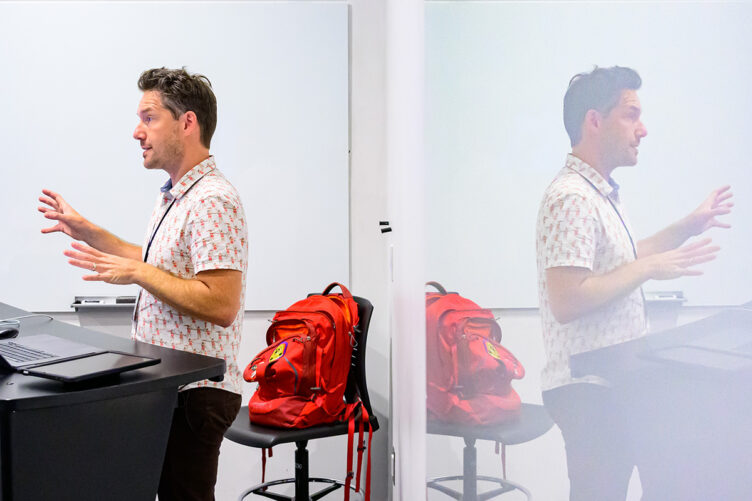
The thriving Illinois community is made up of members of all kinds—students, faculty, staff, volunteers, affiliates, alumni—and many Tech Services staff have long been part of many of these groups. While working full-time for Tech Services, many staff have also served as adjunct faculty and instructors on campus.
Specifically, four of our staff have talked about how working full-time at Tech Services while teaching has helped shape their sense of the Illinois community and have benefitted both roles.
Today, we share about Michael Curtin, innovation coordinator at Tech Services and course instructor of Concept Art for Video Games in the Game Studies and Design program.
When Michael Curtin, former game development designer for Volition Inc. was asked to pitch an art course in the Game Studies program at Illinois, he couldn’t resist; soon, the 2D art course Concept Art for Video Games (GSD 390) was added to the Game Studies and Design program part of Illinois’ Informatics department.
“It’s a crash course in how world-building actually works inside a real game studio. Students start with a loose story prompt and design environments, characters and creatures that all fit together with narrative logic,” Curtin said.
As in a typical game production pipeline, the course begins with creating thumbnails, then creating a black-and-white version, then a full-color one. Throughout the course, Curtin brings in industry experts to “challenge students’ habits and assumptions about games,” he said.
“It’s less about making flashy art and more about creating work that connects and responds to what others on the team are building,” Curtin said. “The goal is to give them a true studio experience – creative, collaborative and grounded in the messy, iterative reality of game development.”
Besides teaching the course he developed, Curtin is an innovation coordinator with Strategic Initiatives & Partnerships at Technology Services. In his role, Curtin helps people navigate technology changes, often focusing on emerging and evolving tools like generative artificial intelligence. Curtin explained his role as innovation coordinator as “part connector, part strategist and part designer of (what I’d call) thoughtful change.”
“I focus on how new tools are introduced, how they’re understood, and how they’re shaped by the people who use them. I’m especially interested in building systems that are responsive, inclusive and sustainable – tools that don’t just get adopted, but that actually serve the long-term goals of the University and its people,” said Curtin.
Curtin’s roots in the Illinois community go way back to his undergraduate years. Since working at the Help Desk as a student at Illinois, he has garnered experience that has taught him how to approach his work and teaching—even today.
“[Working at the Help Desk] taught me to design with empathy: to consider what students need relative to their futures, and how to make the course immersive, engaging and genuinely useful. That mindset guides how I build and refine the class,” he said.
Curtin also explained that the interdisciplinary nature of the game development course has introduced him to people from various corners of campus, and this has also opened more opportunities for collaboration in his Tech Services role, exemplifying the impact of connecting with others across campus.
“My job as innovation coordinator is to make sure innovation doesn’t happen in a vacuum,” he said of his full-time role. On the other hand, “teaching the [Game Studies] course has been a two-way street. While I’m giving students a window into how game development works, I’m also learning from them – how they collaborate, what tools they gravitate toward, and what sparks their creativity (not to mention how they feel about the immediate future). It’s helped me stay grounded in the lived experience of students, and that perspective has real value when thinking about the broader tech strategy on campus,” he said.
“Designing and evolving a course is no small task. It’s pushed me to get better at organizing ideas, testing them quickly and building something that actually works in practice,” said Curtin. “And every lecture is a bit of a performance, which has definitely made me a stronger public-speaker. But more than anything, teaching shows you how people really interact with new ideas – what clicks, what doesn’t, what sparks interest. That kind of perspective is hard to get any other way, and it’s shaped how I approach building systems and strategies that people actually want to use.”
See examples of Curtin’s students’ final projects for the last few semesters: Fall 2023, Spring 2024, Fall 2024.